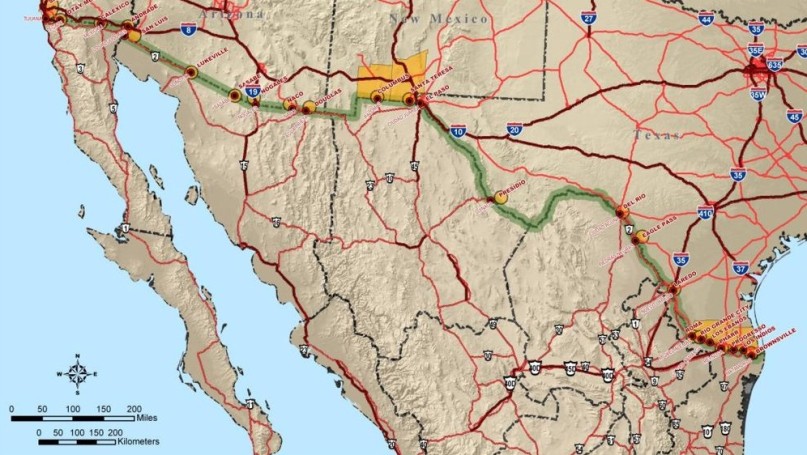
Reporting at the Southern Borders: Journalism and Public Debates on Immigration in the US and the EU
Edited by: Giovanna Dell’Orto and Vicki L. Birchfield
New York: Routledge, 2014
Working as a journalist on the Venezuelan-Colombian frontier many years ago, I came to realise a fundamental truth: national borders only exist in the minds of those in the centres of power. They are indeed socially constructed realities in every single sense, and often represented in the media as a dichotomised world between ‘them’ and ‘the others’. The predominant narrative portrays the border as a revolving door for poor immigrants coming to threaten the cultural identity and way of life of those on the other side.
Moreover, as most surveys indicate, those living in the capitals in Europe and the United States often see the borders as lawless places of clash and conflict. The late Samuel P. Huntington summarised these fears in academic language in the ‘Clash of Civilisations’ (1993) and ‘Who are We? America’s Great Debate’ (2004), which were used in some circles to legitimise what was and still is, by all means, a very problematic worldview of what life and realities along the national borders are.
In reality, the borders are geographical spaces in which tensions, conflict and peaceful cohabitation among the different actors are characterised by both the normal and the extraordinary. They are human communities in which exchanges take place at all levels and which people create networks of collaboration, resistance and survival that in many ways enrich the lives of people on both sides of the borders (Philo et al., 2013: 45). In truth, the U.S. and Europe have been and will continue to be immigrant societies, constantly changing and adapting to the new realities. Any idea that there are ‘natives’ or ‘resident’ cultures is not only misguided, but also deeply misplaced.
However, the worldview of the border as a protective fence, as wrong and unsubstantiated as it might be, has become a very powerful metaphor for power; capable of mobilising voters and influencing decision-making (Bailey and Harindranath, 2005: 275). In the United Kingdom, where I reside, immigration from the Global South is one of the key concerns in the public mind and consequently the area that has received the most attention from legislators in the past 15 years; with more laws and regulations having been issued by the parliament on this subject than the economy, social housing, education or health.
Image and Reality
This disparity between what may or may not be a real issue with the urgency given to immigration can be explained in part by the role of politicians and the news media in setting the agenda. Which is why this book is such a welcome contribution towards the field and, so far, one of the most comprehensive and well-conceived scholarly exercises in the past few years. For a start, it has brought together practitioners and scholars in a way that the collection of essays read coherently as if all were written by a single voice. This has been made possible by the editors, who have done an excellent job by making each one of the authors integrate the other contributions into their own.
The book starts by discussing the policies and politics of immigration in the US and in the European Union. In this first part, the authors set out what the norms of reporting immigration should be. It is not, however, an idealistic or romanticised view, but a very realistic assessment of the key issues that should be addressed, and which approaches should be undertaken by those working in news media outlets.
The second part of the book looks at the framing of immigration and the predominant practices in news organisations. This comparative analysis is insightful of the way in which the media represent these issues. It does so by highlighting in a critical way the distinctive approaches and worldviews in those newsrooms. Parts three and four assess journalistic practices and approaches towards immigration in Europe and in the United States, allowing the professional journalists to reflect critically about their own work. These voices provide a unique opportunity to examine the vicissitudes, problems and challenges that these journalists have to face on a daily basis when reporting immigration.
Finally, the conclusion is an example of how to bring together in a well-rounded way the different contributions and I would say a precise way of ending the book. Overall, this is a sound contribution to the field of journalism studies which underpins the need for other similar works, as this is by no means an open-and-close discussion. Meanwhile, this specific book is going on top of the key readings recommended for my students as any future journalists need to think deep and hard about this subject.
References
Bailey, O. G. and Harindranath, R. (2005). Racialized ‘othering’; the representation of asylum seekers in news media. In Allan, S. (ed). Journalism: critical issues. Maidenhead: Open University Press, 2005, pp. 274-286. Briant et. al.
Philo, G., Briant, E. and Donald, P. (2013). Bad News for Refugees. London: Pluto Press.
Huntington, Samuel P. (2004). Who are We? America’s Great Debate. London: Free Press.
Huntington, Samuel P. (1993). Clash of Civilisations. Foreign Affairs.
